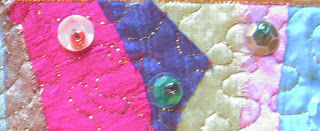Artisanal politics are a whole lot more fun than any other kind, and we donate all the profits to our candidates's campaigns. In 2012 we raised close to $600!
This election season, the Democrats are blessed with a logo that is, like the candidate, brilliant and pragmatic, with secretive details. It's a simple H, but the arrow extending slightly and irrevokably past the rightward bar presents complications.

Because of the protrusion, attempting to piece this design would take me past November. So I made a raw-edge appliqué pattern. Here it is, on a virtual 7 1/2" blue background.
After drawing out the pattern, the next step was to make a PDF with a variety of sizes, to give my incredibly talented artist friend Marian Sunabe. She collaged some beautiful versions. I collaged a few, too. Here are three of Marian's gems:
And two I made:
The next job was to zig-zag over all the raw edges. Then, I attached the patches to things. First, I turned blue-and-white logo into a pocket, and sewed it to a small cross-body bag made from a jeans leg, with the strap made from the seams.
Another bluesy bag:
I crocheted a flap for the back side, and a strap.
For the next bag, I crocheted a colorful strap from ribbon yarn.
The entire bag in the next photo was crocheted around the patch.
A teal model:
Next, a large tote, cut from the leg of a huge pair of denim shorts.
I also sewed patches to plain tee shirts that Marian and her mom had collected:
And finally, when kooks diagnosed Clinton's affection for lumbar pillows as terminal illness (I'm not making this up), I decided to generate some Hillary pillows.
The back message is rubber-stamped.
Say that 10 times fast. The next one, pre stuffing:
...and post-trim and stuffing:
(That green trim has sat in my stash for years awaiting a purpose!)
In the next pillow, Marian used fascinating orange-and-white fabrics for the logo.
You got the idea!
The upcycled jeans cross-body bags have been our bestsellers, so far. Want to make your own? Here's a tutorial.
TUTORIAL: A POLITICAL BAG
For the version below, I shrank the pattern down to about 5 1/4" square. The purple polka-dot vertical strokes in the H are about 1" x 4" (they underlap the arrow.) I cut a template from the paper pattern to trace and cut out the arrow. I used a glue stick to put everything in position. (Washable white school glue works well, too.)
Next, I zigzagged everything down, with paper serving as stabilizer on the back.Ripped away the backing stabilizer. Cut a piece of matching fabric slightly larger.
Placed them right-sides-together, then stitched around three sides, leaving a turning gap along the bottom.
Trimmed the excess seam allowance all the way around, snipped corners, and turned right side out. Pressed the bottom gap closed neatly, and inserted a slice of fusible web to hold it in position.Then topstitched a line horizontally across the top, about 1/8" down from the edge.
Now the pocket is about 5" x 5". Cut a piece of a jeans leg wide enough to be at least an two inches wider than the patch pocket and about 2 1/2 x as long as the patch. I cut it this jeans leg to about 6.5" wide and 18" long (including the turn-under at one end.)
The jeans hem on the left serves as one finished end.
I turned the right end over twice and stitched it down.
Stitched the two long edges of the rectangle with a zig-zag, to minimize fraying.
Tested a jeans pockets to place at the right end. The problem with jeans pocket below is that it's too wide - it might get caught in the seam:
A tiny jeans pocket was the perfect size, and added character:I stitched the H pocket in position, around the sides and bottom. Then I stitched the tiny jeans pocket the same way. My sewing machine does not like thick denim layers, so I only stitched part of the way along the sides and bottom of the jeans pocket. I used strong glue to hold the area under the rivets.
Once pockets were finished, I folded the bag right sides together and stitched down the two side seams. Turned it right side out, and we're almost done.
Crocheted a strap, flap, and added a button.
Added an interesting closure:
It's made of stacked buttons and a crocheted loop.
And there you have it, ready for action!
I'd love to see political items you make! Interested in buying some of these items? We have sold almost all the bags, but do have lots of shirts leftover. Cheap and profits go to the Clinton campaign! Send me an email at cathy(dot)perlmutter(at)gmail.com!


















































